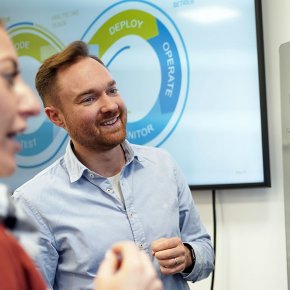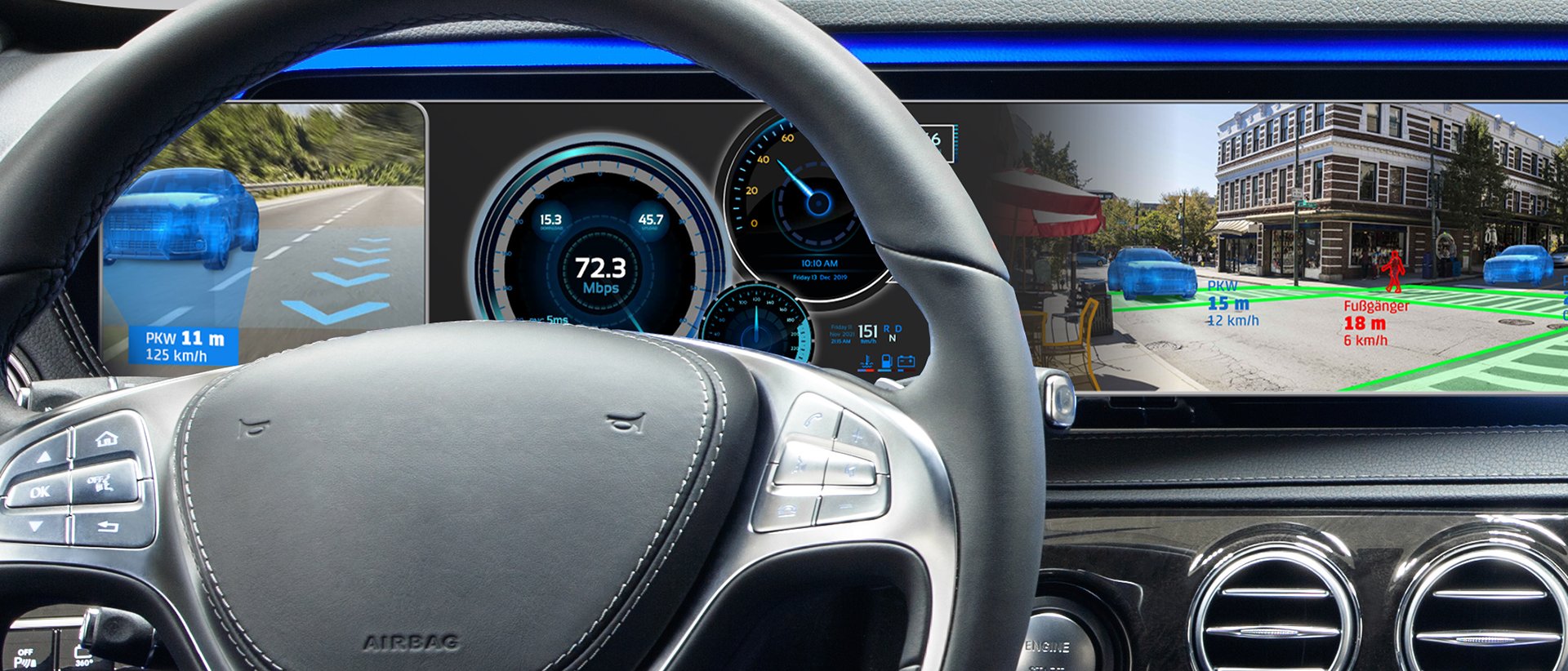

Adaptive rearview mirror
The digitalization of the exterior mirror
The future of the exterior mirror is intuitive, smart and above all: safe.
Vehicles of the current generation enjoy an enormous number of technical innovations. Heads up display, automatic parking, complete voice control: the list of advanced helpers in the car is growing day by day. At first glance, it seems quite strange that such a classic - and important - component as the exterior mirror has taken so long to be digitized. However, what sounds casual and easy to solve, turns out to be a complex interaction between man and machine. Cognizant Mobility has addressed this important aspect of automotive safety - and created a digital implementation with new features.
How much usability is there in the automotive future?
The background against which the development of an adaptive rearview mirror was pushed forward raises questions especially with regard, to usability. Current smartphones, regardless of the manufacturer, use the same basic technology. The situation is different in vehicles. Where one manufacturer installs a touch display the driver must press buttons or turn knobs on the next model - or can control everything by voice because a classic interface has been dispensed with.
This diversity, which is commonly referred to as a wide range of possibilities, is almost inevitable when one considers the rapid development from vehicles to mobile devices. With the vast number of possible and tangible interfaces, a holistic concept is at least a challenge. One may well pause occasionally and assume, in view of the many different options, that features in modern vehicles serve many purposes, but rarely the comfort of the driver.
Why an adaptive rearview mirror in times of autonomous driving?
Many new technologies fall into the infotainment area. However, tomorrow's automated vehicle also contains highly sensitive driving functions that could not be more different. "We're not moving into the autonomous age overnight, after all, we're just handing over control to the machine step by step. But this also means that we will have to let the machine give control back to us for a long time to follow," says Sebastian Miglietta from Cognizant Mobility's UX/UI team. The human-machine interface is therefore of crucial importance, particularly for such automated driving functions.
In A Nutshell
- UX/UI (User Experience & Interface)
- HMI (Human-Machine-Interface)
- Human Factors
- Augmented Reality
- Image Recognition

Sure: It used to be easier. Clutch, gas, brake. No matter what car it was, the operation differed only in details. In highly automated driving, however, only an intuitively understandable interface designed to uniform standards can ensure that drivers know when and how to take over their vehicle again.
And this does not only apply to automated driving. Vehicles from different manufacturers should still be able to differentiate themselves via the user interface. The basic concept should nevertheless be as uniform as possible and offer little room for interpretation. Linking up with learned patterns is an important component here. When new technology finds its way into the car, it should do so in a way that does not require major changes. This is where we close the loop - concepts from the world of smartphones should be incorporated into the development process, as should links to existing driving functions. To illustrate this conceptual model, the exterior mirror is ideally suited.
The digital adaptive exterior mirror
Basically, the adaptive, digital exterior mirror of Cognizant Mobility consists of a high-resolution camera that is mounted on the side of the vehicle. Additional parts are a display area in the dashboard and a gaze detection system.
The latter is required to compensate the major disadvantage of conventional camera-monitor systems. Unlike a standard mirror, the visible image section of such systems is static. To change this, Cognizant Mobility chose an approach that we as car drivers have long been accustomed to: Head movement changes the field of vision in the same way as we are used to with a conventional exterior mirror. If the system detects a head movement to the left or right, for example, the camera image adapts accordingly - and thus enables us to view objects outside the original field of vision. The position of the camera does not have to be changed for this. Only the section of a high-resolution camera image is moved.
This also makes a strengthening effect conceivable, which would mean that even comparatively small head movements would be enough for a shift. If the driver moves their head towards the picture, a digital zoom can also be realized. "From the user experience point of view, the adaptive and digital exterior mirror is a smart solution - the driver can fall back on their accustomed behavior patterns and does not have to learn another new system," says Sebastian Miglietta.
Going new ways without forgetting the tried and tested
The advantages of the adaptive mirror are particularly useful for everyday exercises such as maneuvering and parking the vehicle. The digital counterpart to the classic exterior mirror also opens a range of new functional possibilities that can actively support drivers. Lower air resistance on the vehicle and savings on mechanical components are just some of the other advantages.
Objects in the environment that require the driver's special attention can be made clear with graphics faded into the image - augmented vision, already a reality today. A digital image of the outside world enables night vision functions by supplementing the usual camera image with infrared. For maneuvering operations that do not allow direct visual contact - think of trailers or mobile homes - additional cameras can be attached to the additional object and switched on.
It may take even longer to find common ground in usability across all vehicle manufacturers. The road ahead may also be rocky. However, the digital adaptive exterior mirror shows what will be important in the future: putting people at the center of attention.


